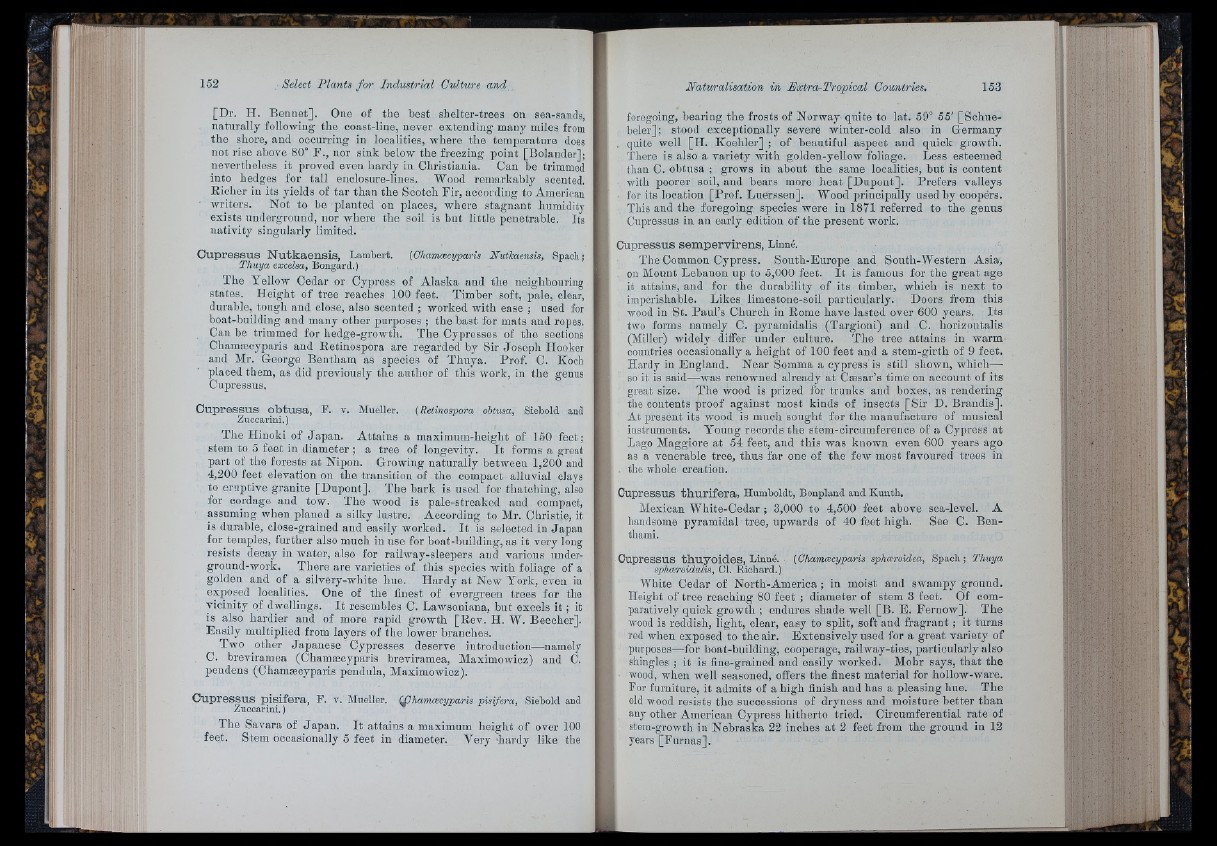
J'^ I è ’1: |^
r 'i’ t fr
152 Select Plants fo r Industrial Culture and
[Dr. H. Bennet]. One of the best shelter-trees on sea-sands,
naturally following the coast-line, never extending many miles from
the sliore, and occurring in localities, where the temperature does
not rise above 80° F., nor sink below the freezing point [Bolander];
nevertheless it proved even hardy in Cliristiania. Can be trimmed
into hedges for tall enolosure-lines. Wood remarkably scented.
Richer in its yields of tar than the Scotch Fir, according to American
writers. Not to be planted on places, where stagnant humidity
exists nnderground, nor where the soil is but little penetrable. Its
nativity singularly limited.
C u p re s s u s N u tis a e n s is , Lambert. (Ghamcecyparis Nutkaensis, Spach;
Thuya excelsa, Bongard.)
The Yellow Cedar or Cypress of Alaska and the neighbouring
states. Height of tree reaches 100 feet. Timber soft, pale, clear,
durable, tough and close, also scented ; worked with ease ; used for
boat-building and many other purposes ; the bast for mats and ropes.
Can be trimmed for hedge-growth. The Cypresses of the sections
Cliammcyparis and Retinospora are regarded by Sir Joseph Hooker
and Mr. George Bentham as species of Thuya. Prof. C. Kock
placed them, as did previously the author of this work, in the genus
Cupressus.
C u p re s s u s o b tu s a , P.
Zuccarini.)
V. Mueller. (Retinospora obtusa, Siebold and
The Hinoki of Japan. Attains a maximum-height of 150 feet;
stem to 5 feet in diameter ; a tree of longevity. I t forms a great
part of the forests a t Nipon. Growing naturally between 1,200 and
4,200 feet elevation on the transition of the compact alluvial clays
to eruptive granite [Dupont], The bark is used for thatching, also
for cordage and tow. The wood is pale-streaked and compact,
assuming when planed a silky lustre. According to Mr. Christie, it
is durable, close-grained and easily worked. I t is selected in Japan
for temples, further also much in use for boat-building, as it very long
resists decay in water, also for railway-sleepers and various underground
work. There are varieties of this species with foliage of a
golden and of a silvery-white hue. Hardy at New York, even iu
exposed localities. Cne of the finest of evergreen trees for the
vicinity of dwellings. I t resembles C. Lawsoniana, but excels it ; it
is also hardier and of more rapid growth [Rev. H. W. Beecher],
Easily multiplied from layers of the lower branches.
Two other Japanese Cypresses deserve introduction—namely
C. breviramea (Chammcyparis breviramea, Maximowicz) and C.
pendens (Chammeyparis pendula, Maximowicz).
C u p re s s u s p is ife ra , F. v. Mueller. Whamoicyparis pisifera, Siebold and
Zuccarini.)
The Savara of Japan. I t attains a maximum height of over 100
feet. Stem occasionally 5 feet in diameter. Very hardy like the
foregoing, bearing the frosts of Norway- quite to lat. 59° 55' [Schuebeler];
stood exceptionally severe winter-cold also in Germany
, quite well [H. Koehler] ; of beautiful aspect and quick growth.
There is also a variety with golden-yellow foliage. Less esteemed
than C. obtusa ; grows in about the same localities, but is content
with poorer soil, and bears more heat [Dupont]. Prefers valleys
■ for its location [Prof. Luerssen]. Wood principally used by coopers.
This and the foregoing species were in 1871 referred to the genus
Cupressus in an early edition of the present work.
Cupressus s em p e rv ir e n s , Linné.
The Common Cypress. South-Europe and South-Western Asia,
on Mount Lebanon up to 5,000 feet. I t is famous for the great age
it attains, and for the durability of its timber, which is next to
Likes limestone-soil partioularly. Doors from this
wood in St. Pau l’s Church in Rome have lasted over 600 years. Its
two forms namely C. pyramidalis (Targioni) and C. horizontalis
(Miller) widely differ under culture. 'Jfhe tree attains in warm
countries occasionally a height of 100 feet and a stem-girth of 9 feet.
Hardy in England. Near Somma a cypress is still shown, which—-
so it is said—was renowned already a t Cæsar’s time on account of its
great size. The wood is prized for trunks and boxes, as rendering
the contents proof .against most kinds of insects [S ir D. Brandis].
At present its wood is much sought for the manufacture of musical
instruments. Young records the stem-oircumference of a Cypress at
Lago Maggiore at 54 feet, and this was known even 600 years ago
as a venerable tree, thus far one of the few most favoured trees in
. the whole creation.
Cupressus th u r if e r a , Humboldt, Bonpland and Kunth.
Mexican White-Cedar ; 3,000 to 4,500 feet above sea-level. A
handsome pyramidal tree, upwards of 40 feet high. See C. Benthami.
Cupressus th u y o id e s , Linné. (Ghamoecyparis sphoeroidea, Spach; Thuya
sphoeroidalis. Cl. Richard.)
White Cedar of North-America ; in moist and swampy ground.
Height of tree reaching 80 feet ; diameter of stem 3 feet. Cf comparatively
quick growth ; endures shade well [B. E. Fernow^]. The
wood is reddish, light, clear, easy to split, soft and fragrant ; it turns
red when exposed to the air. Extensively used for a great variety of
purposes—for boat-building, cooperage, railwray-ties, partioularly also
shingles ; it is fine-grained and easily worked. Mohr says, that the
wood, when well seasoned, offers the finest material for hollow-ware.
For furniture, it admits of a high finish and has a pleasing hue. The
old wood resists the successions of dryness and moisture better than
any other American Cypress hitherto tried. Circumferential rate of
stem-growth in Nebraska 22 inches at 2 feet from the ground in 12
years [Furnas].
fr
i l
r